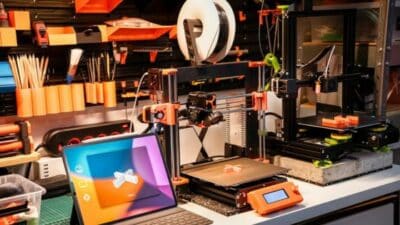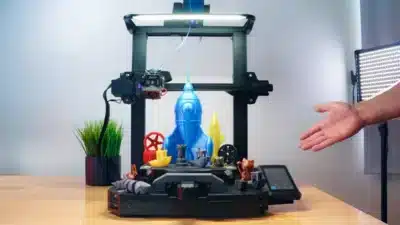3D printed fashion is transforming the way clothes and accessories are designed and made. By using advanced 3D printing technology, you can find unique pieces that blend art, technology, and innovation in a way traditional manufacturing can’t match. This technology allows for customizable, sustainable, and highly intricate fashion designs that push creative limits.
Designers race to experiment with new materials and techniques, creating everything from delicate couture gowns to durable everyday wear. You can explore collections where 3D printed garments serve both as practical clothing and as wearable art, showing how the fashion industry is evolving with this cutting-edge approach.
Whether you’re curious about how 3D printing changes fit and function or interested in the future possibilities, the world of 3D printed fashion offers fresh inspiration that’s shaping what you’ll wear next.
Key Takeaways
- 3D printing enables highly customizable and innovative fashion pieces.
- Leading designers use new materials and technology to reshape clothing design.
- This approach supports sustainable production and future fashion trends.


What Is 3D Printed Fashion?
3D printed fashion combines technology and design in a new way that changes how clothing and accessories are made. It involves creating items layer by layer using digital files, allowing for more customization, less waste, and fresh design possibilities.
Definition and Key Concepts
3D printed fashion uses additive manufacturing to build garments and accessories by layering materials such as plastic, resin, or flexible filaments. Instead of cutting and sewing fabric, this process assembles your clothing directly from digital patterns.
You create a digital design on specialized software. That design then guides the printer as it builds your item bit by bit.
Key benefits include waste reduction and precise customization. Because the process only uses the material it needs, it helps reduce the textile waste common in traditional fashion.
How 3D Printing Is Revolutionizing Fashion
With 3D printing, you can have clothes custom-fit to your exact measurements. This technology cuts down production time and cost since patterns and fittings happen digitally.
It offers a sustainable solution by eliminating excess fabric waste and reducing the need for shipping physical samples between designers and manufacturers.
You’ll also find you can experiment with complex shapes and textures unachievable by traditional sewing, opening new creative routes for designers in the fashion industry.
Types of 3D Printed Fashion Items
3D printed fashion includes:
- Apparel: Dresses, tops, and outerwear combining flexible materials for wearability.
- Footwear: Custom-fit shoes with intricate designs for comfort and style.
- Accessories: Jewelry, bags, and eyewear benefiting from precision and unique shapes.
Each item varies depending on the material and printer type used. You can even eventually print entire outfits or mix 3D printed elements with traditional fabric for hybrid products.


Popular Applications and Innovations
You can explore 3D printing in fashion through varied uses, from creating entire garments to designing unique accessories and even footwear. This technology brings new levels of customization and creativity to your wardrobe.
3D Printed Apparel
With 3D printing, you can get apparel that showcases intricate patterns and shapes not possible with traditional methods. Designers use this tech to build garments layer by layer, allowing for lightweight and flexible pieces that fit your body closely.
Some items, like skirts and tops, use advanced materials that balance durability with comfort. This method also reduces waste since materials are added only where needed. Innovations in filament flexibility have made 3D printed clothes more wearable and less rigid than before.
Accessories and Personalization
You can create highly personalized accessories such as ties, jewelry, and hats with 3D printers. These pieces often feature complex geometries, allowing for one-of-a-kind designs tailored exactly to your taste.
3D printing lets you experiment with shapes, sizes, and textures that standard mass production can’t easily replicate. This personalization extends your fashion possibilities, giving you accessories that reflect your unique style and preference.
3D Printed Footwear
When it comes to shoes, 3D printing offers precise customization for fit and comfort. You can find 3D printed soles designed to improve support and reduce weight, using specialized materials that maintain durability.
The process allows you to modify designs easily, adapting features like cushioning or arch support for your needs. Many brands are integrating this technology, blending traditional craftsmanship with 3D printed components to deliver innovative footwear solutions.


Leading Designers and Brands in 3D Printed Fashion
You’ll find impressive names pushing the boundaries of 3D printed fashion, blending technology and creativity. These designers and brands bring unique approaches, from haute couture to wearable accessories, that show how 3D printing shapes the industry today.
Pioneers and Industry Leaders
Iris van Herpen is often recognized as a pioneer in 3D printed fashion. Her work includes the famous Crystallization top, one of the first garments made with 3D printing worn on the runway. She combines craftsmanship with high technology to create intricate patterns and textures.
Other leaders include emerging designers who focus on sustainability. These innovators use 3D printing to reduce waste and energy compared to traditional manufacturing. Brands specializing in footwear and jewelry are early adopters, but more garment designers are entering the space, especially in haute couture.
You should also watch for smaller studios and tech-focused brands that experiment heavily with new materials and adaptive designs, bringing personalized and eco-friendly fashion closer to you.
Notable Collaborations and Collections
Several high-profile collaborations have showcased the potential of 3D printed fashion. For instance, partnerships between 3D printing companies and established fashion houses often result in limited-edition runs of unique pieces like shoes, accessories, or custom garments.
Brands have pushed this further by releasing collections that combine traditional techniques with 3D printing innovation. These collections highlight the versatility and customization that 3D printing offers, allowing you to experience fashion that is both futuristic and functional.
You’ll find projects featuring 3D printed Apple Watch bands, jewelry, and avant-garde runway pieces that blur the line between fashion and technology. Such collaborations help bring 3D printed fashion into mainstream awareness and make it accessible to a wider audience.


Technology and Materials in 3D Printed Fashion
Understanding how 3D printing technologies and materials work together can help you appreciate the possibilities in modern fashion. The choices you make for printing techniques and materials affect design complexity, durability, and environmental impact.
3D Printing Techniques Used in Fashion
You’ll often encounter additive manufacturing methods like Fused Deposition Modeling (FDM) and Selective Laser Sintering (SLS) in 3D printed fashion.
- FDM builds objects layer by layer by melting thermoplastic filaments, ideal for creating flexible and lightweight garments.
- SLS uses lasers to fuse powdered materials, producing stronger, more detailed pieces perfect for accessories or structured garments.
Direct-to-textile printing, such as 3DFashion™ technology, also allows you to print full-color designs directly onto fabrics, opening up new visual possibilities.
These techniques let you design intricate shapes and custom fits that traditional methods can’t easily achieve, pushing creative boundaries while streamlining production.
Materials and Sustainability
In 3D printed fashion, you’ll work primarily with polymers like nylon, PLA (polylactic acid), and flexible TPU (thermoplastic polyurethane). Nylon is popular for its strength and flexibility, while PLA offers a biodegradable option derived from renewable resources.
Some designers use polymer-fiber composites to combine durability with fabric-like textures. These materials can reduce waste compared to conventional cut-and-sew fashion because additive manufacturing only uses what’s necessary.
Sustainability is increasingly a focus. You can choose recycled or bio-based filaments to lower your environmental footprint. The customization possible with 3D printing also helps minimize overproduction and excess inventory.


Future Trends and Impact of 3D Printed Fashion
3D printing is shaping the future of how fashion is created and consumed, impacting market dynamics, creative design, and sustainability. You’ll see faster adoption among brands, new design opportunities, and positive environmental shifts as the technology matures.
Market Growth and Adoption
The fashion industry is increasingly adopting 3D printing to meet demand for rapid, customized production. You can expect brands to use this tech not just for prototypes but for ready-to-wear garments.
This growth is driven by the ability to reduce lead times from design to shelf, letting you respond to trends quickly. Big names and startups alike are investing in 3D-printed collections, indicating wider market acceptance.
By integrating 3D printing, your favorite brands can minimize overproduction, cutting excess inventory costs. The growing availability of consumer-level 3D printers also hints at future options for personalized fashion at home.


Creative Possibilities and Challenges
3D printing unlocks design freedom that traditional methods struggle to achieve. You can explore intricate patterns, unusual textures, and structures that are hard or impossible to produce using fabric and stitching alone.
This technology lets you customize clothes precisely to body shapes, enhancing comfort and fit. Plus, you’ll find options for downloadable designs to print yourself, broadening your access to unique pieces.
However, there are challenges in material limitations, durability, and scalability. You might face issues with fabric-like softness or breathability, which 3D printing still works to improve. Designers also need new skills to fully utilize this tech.
Environmental and Social Impact
3D printing in fashion can reduce waste significantly by producing only what you need, when you need it. This helps cut down on the huge volume of unsold clothing typical in fast fashion.
The technology promotes the use of eco-friendly materials and minimizes water and chemical use involved in traditional textile production. This aligns with efforts to meet sustainability goals and reduce the industry’s carbon footprint.
Socially, 3D printing could democratize fashion by lowering barriers to entry for designers and consumers. You could potentially create or own customized garments without the environmental and economic costs of mass manufacturing.
- 520shares
- Facebook0
- Pinterest520
- Twitter0



